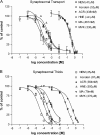Molecular mechanisms of the conjugated alpha,beta-unsaturated carbonyl derivatives: relevance to neurotoxicity and neurodegenerative diseases
- PMID: 18083715
- PMCID: PMC2734294
- DOI: 10.1093/toxsci/kfm301
Molecular mechanisms of the conjugated alpha,beta-unsaturated carbonyl derivatives: relevance to neurotoxicity and neurodegenerative diseases
Abstract
Conjugated alpha,beta-unsaturated carbonyl derivatives such acrylamide, acrolein, and 4-hydroxy-2-nonenal (HNE) are members of a large class of chemicals known as the type-2 alkenes. Human exposure through diet, occupation, and pollution is pervasive and has been linked to toxicity in most major organs. Evidence suggests that these soft electrophiles produce toxicity by a common mechanism involving the formation of Michael-type adducts with nucleophilic sulfhydryl groups. In this commentary, the adduct chemistry of the alpha,beta-unsaturated carbonyls and possible protein targets will be reviewed. We also consider how differences in electrophilic reactivity among the type-2 alkenes impact corresponding toxicokinetics and toxicological expression. Whereas these concepts have mechanistic implications for the general toxicity of type-2 alkenes, this commentary will focus on the ability of these chemicals to produce presynaptic damage via protein adduct formation. Given the ubiquitous environmental presence of the conjugated alkenes, discussions of molecular mechanisms and possible neurotoxicological risks could be important. Understanding the neurotoxicodynamic of the type-2 alkenes might also provide mechanistic insight into neurodegenerative conditions where neuronal oxidative stress and presynaptic dysfunction are presumed initiating events. This is particularly germane to a recent proposal that lipid peroxidation and the subsequent liberation of acrolein and HNE in oxidatively stressed neurons mediate synaptotoxicity in brains of Alzheimer's disease patients. This endogenous neuropathogenic process could be accelerated by environmental type-2 alkene exposure because common nerve terminal proteins are targeted by alpha,beta-unsaturated carbonyl derivatives. Thus, the protein adduct chemistry of the conjugated type-2 alkenes offers a mechanistic explanation for the environmental toxicity induced by these chemicals and might provide insight into the pathogenesis of certain human neurodegenerative diseases.
Figures



References
-
- Arakawa M, Ushimaru N, Osada N, Oda T, Ishige K, Ito Y. N-acetylcysteine selectively protects cerebellar granule cells from 4-hydroxynonenal-induced cell death. Neurosci. Res. 2006;55:255–263. - PubMed
-
- Arlt S, Beisiegel U, Kontush A. Lipid peroxidation in neurodegeneration: New insights into Alzheimer's disease. Curr. Opin. Lipidol. 2002;13:289–294. - PubMed
-
- Balice-Gordon RI, Lichtman JW. Long-term synapse loss induced by focal blockade of postsynaptic receptors. Nature. 1994;372:519–524. - PubMed
-
- Barber DS, Hunt JR, Ehrich M, Lehning EJ, LoPachin RM. Metabolism, toxicokinetics and hemoglobin adduct formation in rats following subacute and subchronic acrylamide dosing. Neurotoxicology. 2001;22:341–353. - PubMed
-
- Barber DS, LoPachin RM. Proteomic analysis of acrylamide-protein adduct formation in rat brain synaptosomes. Toxicol. Appl. Pharmacol. 2004;201:120–136. - PubMed
Publication types
MeSH terms
Substances
Grants and funding
LinkOut - more resources
Full Text Sources
Other Literature Sources
Medical

